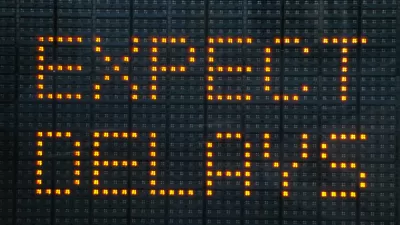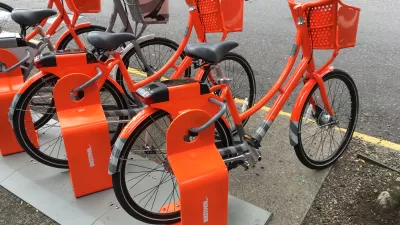With the Olympic games, and millions of visitors, descending on London this summer, Sarah Lyall looks at how the capital city is hoping to spare users of its ancient road network and temperamental subway system from a transportation nightmare.
For a city renowned for its unpredictable congestion, city officials are pulling out all the stops to try to prevent transportation chaos during the two weeks of Olympic games. Lyall explores these efforts, which range from prioritized Olympic traffic lanes to outright scare tactics.
"London's commuters have been warned to expect gridlock on the roads and paralysis on the subways. They have been advised to leave home well before rush hour; to travel by foot, bicycle or boat; and to forget about trying to drive anywhere even remotely connected with the Olympics."
"The government has braced itself for the onslaught with a $10.2 billion spending spree on transportation improvements over the last seven years. It has increased capacity on some train and subway lines, spruced up others and built new services like the javelin train, which travels between St. Pancras and Olympic Park in a cool seven minutes (when it works), a trip that would normally take about half an hour."
"Tony Travers, director of the Greater London Group at the London School of Economics, said all the planning in the world could not remove the two biggest obstacles to a happy traveling experience in London: the city's twisty, snarly, ancient road network and its temperamental subway system."
FULL STORY: Londoners Dread Traffic as City Plans Olympics

Alabama: Trump Terminates Settlements for Black Communities Harmed By Raw Sewage
Trump deemed the landmark civil rights agreement “illegal DEI and environmental justice policy.”

Planetizen Federal Action Tracker
A weekly monitor of how Trump’s orders and actions are impacting planners and planning in America.

The 120 Year Old Tiny Home Villages That Sheltered San Francisco’s Earthquake Refugees
More than a century ago, San Francisco mobilized to house thousands of residents displaced by the 1906 earthquake. Could their strategy offer a model for the present?

In Both Crashes and Crime, Public Transportation is Far Safer than Driving
Contrary to popular assumptions, public transportation has far lower crash and crime rates than automobile travel. For safer communities, improve and encourage transit travel.

Report: Zoning Reforms Should Complement Nashville’s Ambitious Transit Plan
Without reform, restrictive zoning codes will limit the impact of the city’s planned transit expansion and could exclude some of the residents who depend on transit the most.

Judge Orders Release of Frozen IRA, IIJA Funding
The decision is a victory for environmental groups who charged that freezing funds for critical infrastructure and disaster response programs caused “real and irreparable harm” to communities.
Urban Design for Planners 1: Software Tools
This six-course series explores essential urban design concepts using open source software and equips planners with the tools they need to participate fully in the urban design process.
Planning for Universal Design
Learn the tools for implementing Universal Design in planning regulations.
Clanton & Associates, Inc.
Jessamine County Fiscal Court
Institute for Housing and Urban Development Studies (IHS)
City of Grandview
Harvard GSD Executive Education
Toledo-Lucas County Plan Commissions
Salt Lake City
NYU Wagner Graduate School of Public Service





























